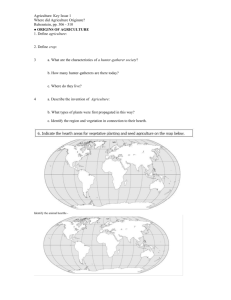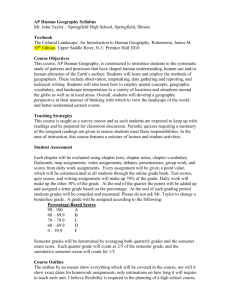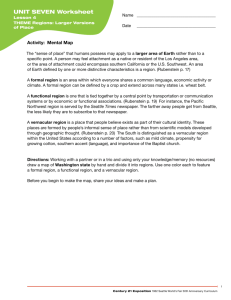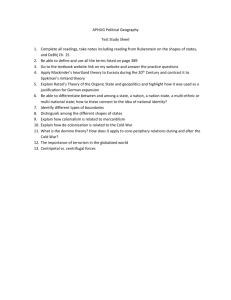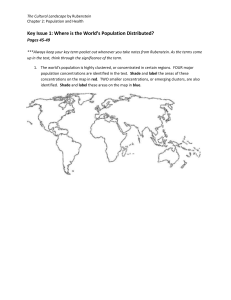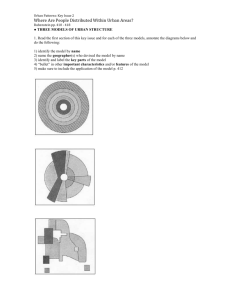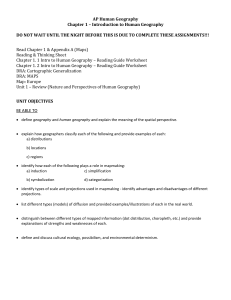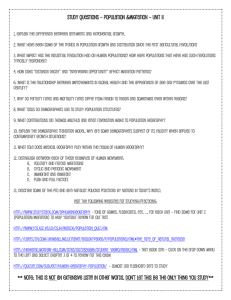AP Human Geography Syllabus
advertisement
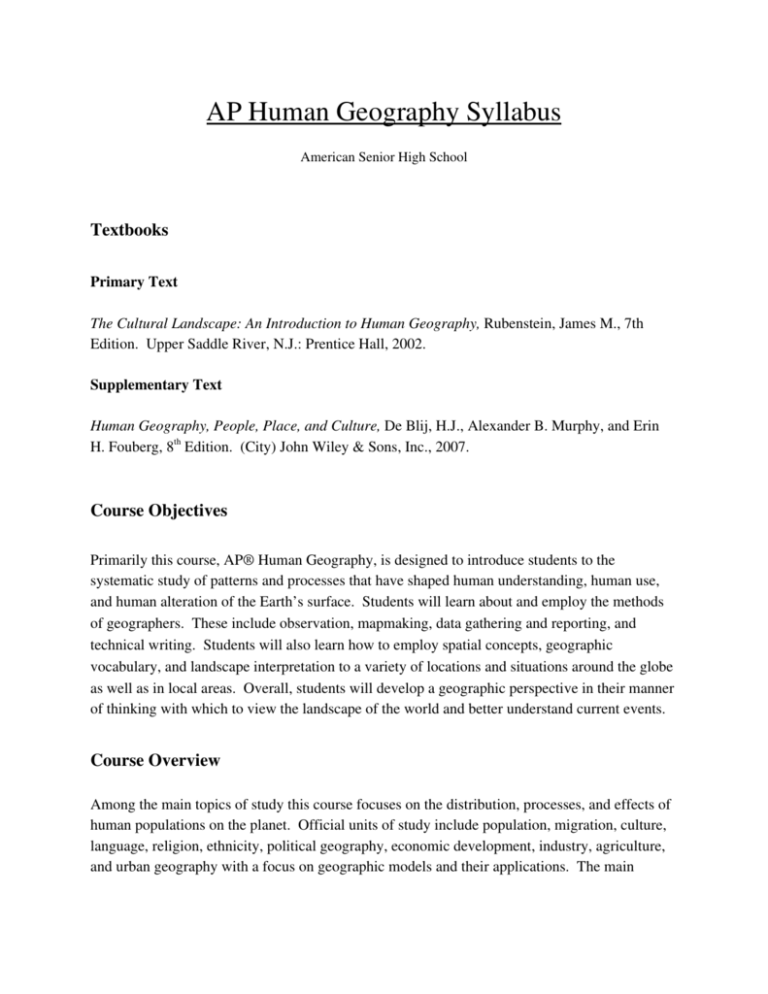
AP Human Geography Syllabus American Senior High School Textbooks Primary Text The Cultural Landscape: An Introduction to Human Geography, Rubenstein, James M., 7th Edition. Upper Saddle River, N.J.: Prentice Hall, 2002. Supplementary Text Human Geography, People, Place, and Culture, De Blij, H.J., Alexander B. Murphy, and Erin H. Fouberg, 8th Edition. (City) John Wiley & Sons, Inc., 2007. Course Objectives Primarily this course, AP® Human Geography, is designed to introduce students to the systematic study of patterns and processes that have shaped human understanding, human use, and human alteration of the Earth’s surface. Students will learn about and employ the methods of geographers. These include observation, mapmaking, data gathering and reporting, and technical writing. Students will also learn how to employ spatial concepts, geographic vocabulary, and landscape interpretation to a variety of locations and situations around the globe as well as in local areas. Overall, students will develop a geographic perspective in their manner of thinking with which to view the landscape of the world and better understand current events. Course Overview Among the main topics of study this course focuses on the distribution, processes, and effects of human populations on the planet. Official units of study include population, migration, culture, language, religion, ethnicity, political geography, economic development, industry, agriculture, and urban geography with a focus on geographic models and their applications. The main purpose of the course is to utilize geographic processes to systematically study and understand spatial patterns that are evident in the world in which we live. Teaching Strategies This course is taught as a survey course and as such students are expected to keep up with readings and be prepared for classroom discussion. Periodic reading quizzes requiring a summary of the assigned readings are given to ensure students meet these responsibilities. In the area of instruction this course features a mixture of lectures and student activities. There are two types of writing assignments utilized in the course. All Chapter and Unit tests include free­response questions (Essays) since those questions represent fifty percent of the AP Exam. Students are also assigned free­response questions periodically over the course of the school year. Responses are graded using a scoring guideline similar to that which is used to score the AP Exam. Student Assessment At the end of each grading period (9 weeks) student grades will be compiled and measured will the following percentages designed to emulate the AP European History Exam. 40 % = Chapter and Unit Tests. Each weighted equally. 40 % = Free­response questions (Essays). Each weighted equally. 20 % = Reading Quizzes. Each weighted equally. Percentage Based Scores 90 – 100 = A 80 – 89 = B 70 – 79 = C 60 – 69 = D 0 – 59 = F Four Point Scale 3.5 – 4.0 = A 2.5 – 3.4 = B 1.5 – 2.4 = C 1.0 – 1.4 = D 0 – 0.9 = F Course Outline: Textbook Readings and Lesson Objectives The course is divided into two semesters. There are nine conceptual Units paced over the thirty­ two weeks (AP Exams are typically given in early May) prior to the AP Exam. This outline by no means shows everything which will be covered in the course, nor will it show exact dates, only estimations on how long it will require to teach various Units. I firmly believe flexibility is required in the planning of any high school course so I prefer guidelines to specific day by day dictates. This outline is meant to provide a pacing for the instruction as well as a more detailed understanding of the objectives students will pursue. Unit 1: Geography: Its Nature and Perspectives (2 weeks) Readings ­ Rubenstein, Chapter 1: “Thinking Geographically” Objectives – Students will be able to … Define geography, human geography. Explain the meaning of the spatial perspective. Explain how geographers classify and provide examples of distributions, locations, regions. Identify how simplification, categorization, symbolization and induction play roles in mapmaking. • Identify types of scale and projections used in mapmaking. • Identify advantages and disadvantages of different projections. • List different types (models) of diffusion and provide examples/illustrations of each in the real world. • Distinguish between different types of maps and mapped information and provide explanations of strengths and weaknesses of each. • • • • Unit 2: Population Geography (4 weeks) Readings ­ Rubenstein, Chapter 2: “Population” Rubenstein, Chapter 3: “Migration” Objectives – Students will be able to … • • • Map major and emerging population concentrations and describe the demographic characteristics of each. Consider the concepts of ecumene and nonecumene. Describe the strengths and weaknesses of each for demographic analysis. • • • • • • • • • • • • • • • • Explain the elements of a population pyramid and distinguish between characteristic shapes. Explain the demographic transition model in detail. Provide examples of pro­ and antinatalist policies and their effects in example countries. Define key demographic terms and identify regions in which high and low extreme examples of each can be found. List various types of natural hazards and disasters. Map geographical areas most affected by natural hazards and disasters. Hypothesize the degree of danger in various regions. Discuss methods that are taken to adapt to these dangers. Distinguish between and give characteristics of various types of human movement including circulation, forced and voluntary migration, and push and pull factors Discuss the contributions of Ravenstein to the study of human movement and migration. Use the gravity model to predict migration and evaluate its efficiency and usefulness. Map specific examples of historic and contemporary forced migrations, explaining push and pull factors associated with each. Characterize a refugee and refugee populations. Discuss the migration history of the United States through immigration history and policy, historic and contemporary streams of migration, and internal migration patterns Explain how distance decay, intervening obstacles, and migration selectivity factors affect migration and circulation patterns. Correlate migration patterns to the demographic transition model. Unit 3: Cultural Patterns and Processes (4 weeks) Readings ­ Rubenstein, Chapter 4: “Folk and Popular Culture” Rubenstein, Chapter 5: “Language” Objectives – Students will be able to … • • • • • • • • • • Define culture and cultural geography. Compare and contrast the various aspects of folk and popular culture. Examine specific examples of folk culture and regions. Examine examples of specific popular cultural traits and discuss their diffusion. Discuss ways in which cultural traits are affected by and affect the natural environment. Discuss the role of racism and ethnocentrism in the understanding of the cultural landscape. Discuss the importance and role of language as an element of culture. Explain how languages are classified and related. Map the distribution of major language families worldwide. Show the division of Europe into language groups and give specific examples from major groups. • • • • Describe the unique characteristics of English. Explain the how, why, and where of language change. Discuss the regional and local variety in language using the terms slang, isogloss and accent. Explain how toponyms are derived and classified and give various examples of them. Unit 4: Political Organization of Space (7 weeks) Readings ­ Rubenstein, Chapter 6: “Religion” Rubenstein, Chapter 7: “Ethnicity” Rubenstein, Chapter 8: “Political Geography” Objectives – Students will be able to … • • • • • • • • • • • • • • • Identify the fundamental characteristics of all major religions including point of origin, method of diffusion, current distribution and landscape expression. Distinguish between ethnic and universalizing religions. Describe ways in which the environment influences religion and ways in which religions affect the natural environment. Discuss various specific religious conflicts around the world in terms of religion versus politics, interfaith conflicts and intrafaith conflicts. Describe the distribution of major ethnicities within the United States. Examine case studies of ethnic conflicts from different regions. Consider ways in which gender­related issues are expressed spatially, particularly economic roles and activity, health and reproduction, and level of education. Discuss various nation­state configurations and illustrate them with examples. Explain the concept of state by identifying necessary qualifications and characteristics, listing examples of states in various regions and describing quasi­states. Describe the problems of multinational states and stateless nations. List advantages and disadvantages of different types of boundaries and provide real­world examples of natural/physical boundaries, cultural boundaries and geometric boundaries. List advantages and disadvantages of different shapes of states and provide examples. Discuss the concepts of imperialism and colonialism and illustrate some of their consequences on the contemporary political map. Define irredentism and devolution and illustrate with examples. Summarize the history of the United Nations and identify issues of current importance confronting it. Unit 5: Economic Development (3 weeks) Readings ­ Rubenstein, Chapter 9: “Development” Objectives – Students will be able to … • • • • • Use examples of human welfare indicators to distinguish between relatively developed and less developed countries. Use examples of economic indicators to classify countries as less developed or relatively developed. Draw the Brandt line on a world or regional map. Compare and contrast different theories and models of economic development and the relationship between less developed and relatively developed countries. Provide examples of the different sectors of a country’s economy and explain the economic relationship between them. Unit 6: Agriculture and Rural Land Use (3 weeks) Readings ­ Rubenstein, Chapter 10: “Agriculture” Objectives – Students will be able to … • • • • • • • Explain how agriculture originated and identify its various hearths. Describe the evolution of agricultural practices from their first use until today through historical periods including the Neolithic Revolution, Second Agricultural Revolution, Green Revolution and biotechnology. Consider how factors such as climate, terrain, culture, and the relation to world markets correlate with specific agricultural regions. Describe and apply the von Thünen model to both small­ and large­scale situations. Identify the predominant agricultural practices associated with various regions of the world. Use agricultural practice to differentiate between less developed and relatively developed countries. Compare and contrast different types of rural landscapes and settlements including linear villages, cluster villages, and dispersed settlements. Unit 7: Industrialization (3 weeks) Readings ­ Rubenstein, Chapter 11: “Industry” Objectives – Students will be able to … • • • • • • Explain the Industrial Revolution by describing its origin, describing its diffusion and describing its current pattern of industrial regions. Map regional manufacturing zones in each continent and for each identify the following; origin and resources, current strengths and/or problems. Compare and contrast preindustrial, industrial, and postindustrial life and landscape. Describe how site and situation factors influence the location of manufacturing and give examples. Discuss the problems created by or associated with industrialization in developed countries and in developing countries. Make graphic models that describe the inputs and connections of various industries. Unit 8: Cities and Urban Land Use (4 weeks) Readings ­ Rubenstein, Chapter 12: “Services” Rubenstein, Chapter 13: “Urban Patterns” Objectives – Students will be able to … • • • • • • • • Contrast European and North American cities by comparing their central business districts, suburbs, and suburban growth. Compare and contrast elements of various urban models including the concentric zone, sector, multiple­nuclei, and galactic city/edge cities. Describe the move of retail and industry to the suburbs. Explain the growth of suburbs in terms of social, transportation, and economic changes. Differentiate between three models of North American cities. Compare and contrast spatial characteristics of cities in various regions including Latin America, Africa and Southeast Asia. List and evaluate the problems of the inner city. Explain and illustrate important models dealing with the urban hierarchy including central­place theory, rank­size rule and primate cities. Unit 9: Looking Ahead (2 weeks) Readings ­ Rubenstein, Chapter 14: “Key Issue 1” Rubenstein, Chapter 14: “Key Issue 2” Rubenstein, Chapter 14: “Key Issue 3”
